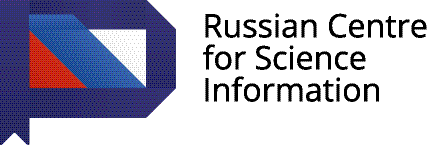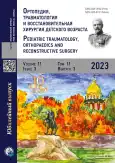Computed tomography-guided intraoperative navigation in children with congenital scoliosis versus freehand/fluoroscopy methods
- 作者: Abdaliyev S.S.1, Yestay D.Z.1,2, Vissarionov S.V.3, Baitov D.T.1, Serikov S.Z.1, Chsherbina A.Y.1
-
隶属关系:
- National Scientific Center of Traumatology and Orthopedics named after academician N.D. Batpenov
- Karaganda Medical University
- H. Turner National Medical Research Center for Сhildren’s Orthopedics and Trauma Surgery
- 期: 卷 11, 编号 3 (2023)
- 页面: 307-314
- 栏目: Clinical studies
- URL: https://bakhtiniada.ru/turner/article/view/148233
- DOI: https://doi.org/10.17816/PTORS473150
- ID: 148233
如何引用文章
详细
BACKGROUND: The choice of techniques for the treatment of children with congenital spinal deformities remains one of the most significant problems of spinal surgery. This topic is relevant given the peculiarities of the disease course, severity and rigidity of deformities, their steady and rapid progression, formation of compensatory curvature, and a significant decrease in the quality and life expectancy of patients.
AIM: To compare screw misposition, adverse outcomes, intraoperative blood loss, and time required for pedicle screw placement with further deformity correction under computed tomography (CT) guidance with intraoperative navigation versus fluoroscopy.
MATERIALS AND METHODS: This single-center, prospective comparative study was conducted from 2019 to 2022 at the National Scientific Center of Traumatology and Orthopedics named after academician N.D. Batpenov. Patient demographics and surgical outcomes were obtained from the medical records. All patients underwent a comprehensive clinical and radiological examination before surgery, after surgery, and at the stages of dynamic observation. Data of patients with congenital malformations of the spine were analyzed. The study involved 42 patients aged 3–18 years with congenital kyphoscoliosis of the thoracic and/or lumbar spine. The patients were divided into two groups according to the method of surgical correction used: the O-arm navigation group and the C-arm group.
RESULTS: Data of patients who underwent surgery for congenital scoliosis of the spine were analyzed. The patients were divided into the O-arm navigation group, which included patients who underwent surgery using the O-arm mobile intraoperative CT with the seventh-generation Stealth Station navigation system in combination with intraoperative neuromonitoring, and the C-arm group, which included patients who underwent surgery under the control of the intraoperative C-arm. In both groups, 364 screws were placed, of which 189 screws were placed under neuronavigation, and 175 screws were placed using the C-arm. The effectiveness of the intraoperative neuronavigation system in combination with neuromonitoring showed 97.11% correct placement (grades A and B) of pedicle screws. The use of an intraoperative C-arm showed 89.63% (grades A and B) correctness. The proportion of misplaced screws corresponding to Gertzbein–Robbins classes C–E was higher in the C-arm group (10.37%) than in the navigation group (1.49%) (p ≤ 0.005). No severe neurological disorders, postoperative infection, or adverse clinical outcomes were observed in both groups.
CONCLUSIONS: The installation of pedicle screws using CT-guided navigation (O-arm) did not prolong the operation time, did not increase blood loss, and reduced the risk of screw mispositioning compared with freehand and fluoroscopy pedicle screw placement.
作者简介
Seidali Abdaliyev
National Scientific Center of Traumatology and Orthopedics named after academician N.D. Batpenov
Email: abdaliev73@mail.ru
ORCID iD: 0000-0001-7439-141X
MD, PhD, Cand. Sci. (Med.)
哈萨克斯坦, AstanaDaniyar Yestay
National Scientific Center of Traumatology and Orthopedics named after academician N.D. Batpenov; Karaganda Medical University
编辑信件的主要联系方式.
Email: daniyar.estay@gmail.com
ORCID iD: 0000-0003-3583-6871
orthopedic surgeon
哈萨克斯坦, Astana; KaragandaSergei Vissarionov
H. Turner National Medical Research Center for Сhildren’s Orthopedics and Trauma Surgery
Email: vissarionovs@gmail.com
ORCID iD: 0000-0003-4235-5048
SPIN 代码: 7125-4930
Scopus 作者 ID: 6504128319
Researcher ID: P-8596-2015
MD, PhD, Dr. Sci. (Med.), Professor, Corresponding Member of RAS
俄罗斯联邦, Saint PetersburgDaulet Baitov
National Scientific Center of Traumatology and Orthopedics named after academician N.D. Batpenov
Email: boika_88@mail.ru
ORCID iD: 0009-0000-9837-0381
orthopedic surgeon
哈萨克斯坦, AstanaSerik Serikov
National Scientific Center of Traumatology and Orthopedics named after academician N.D. Batpenov
Email: serik_140@mail.ru
ORCID iD: 0000-0003-0982-9299
orthopedic surgeon
哈萨克斯坦, AstanaAlexandr Chsherbina
National Scientific Center of Traumatology and Orthopedics named after academician N.D. Batpenov
Email: a999333@mail.ru
ORCID iD: 0009-0005-0127-2037
orthopedic surgeon
哈萨克斯坦, Astana参考
- Lenke LG, Kuklo TR, Ondra S, et al. Rationale behind the current state-of-the-art treatment of scoliosis (in the pedicle screw era). Spine (Phila Pa 1976). 2008;33(10):1051–1054. doi: 10.1097/BRS.0b013e31816f2865
- Zindrick MR, Knight GW, Sartori MJ, et al. Pedicle morphology of the immature thoracolumbar spine. Spine (Phila Pa 1976). 2000;25(21):2726–2735. doi: 10.1097/00007632-200011010-00003
- Hicks JM, Singla A, Shen FH, et al. Complications of pedicle screw fixation in scoliosis surgery: a systematic review. Spine (Phila Pa 1976). 2010;35(11):E465–E470. doi: 10.1097/BRS.0b013e3181d1021a
- Ryabykh SO, Filatov EYu, Savin DM. Results of hemivertebra excision through combined, posterior and transpedicular approaches: systematic review. Russian Journal of Spine Surgery (Khirurgiya Pozvonochnika). 2017;14(1):14–23. doi: 10.14531/ss2017.1.14-23
- Baghdadi YM, Larson AN, McIntosh AL, et al. Complications of pedicle screws in children 10 years or younger: a case control study. Spine (Phila Pa 1976). 2013;38(7):E386–E393. doi: 10.1097/BRS.0b013e318286be5d6
- Kokushin DN, Vissarionov SV, Baindurashvili AG. Comparative analysis of pedicle screw placement in children with congenital scoliosis: freehand technique (in vivo) and guide templates (in vitro). Traumatology and Orthopedics of Russia. 2018;24:53–63. (In Russ.) doi: 10.21823/2311-2905-2018-24-4-53-63
- Larson AN, Santos ER, Polly DW Jr, et al. Pediatric screw placement using intraoperative CT and 3D image-guided navigation. Spine (Phila Pa 1976). 2012;37(3):E188–E194. doi: 10.1097/BRS.0b013e31822a2e0a
- Vissarionov SV, Drozdetsky AP, Kokushin DN, Belyanchikov SM. Correction of idiopathic scoliosis under 3D-CT navigation in children. Russian Journal of Spine Surgery (Khirurgiya Pozvonochnika). 2012;(2):30-36. (In Russ.) doi: 10.14531/ss2012.2.30-36
- Gertzbein SD, Robbins SE. Accuracy of pedicular screw placement in vivo. Spine (Phila Pa 1976). 1990;15(1):11–14. doi: 10.1097/00007632-199001000-0000415:11-14
- Shillingford JN, Laratta JL, Sarpong NO, et al. Instrumentation complication rates following spine surgery: a report from the Scoliosis Research Society (SRS) morbidity and mortality database. J Spine Surg. 2019;5(1):110–115. doi: 10.21037/jss.2018.12.09
- Floccari LV, Larson AN, Crawford CH, et al. Which malpositioned screws should be revised? J Pediatr Orthop. 2018;8(2):110–115. doi: 10.1097/BPO.0000000000000753
- Ledonio CG, Polly DW Jr, Vitale MG, et al. Pediatric pedicle screws: comparative effectiveness and safety: a systematic literature review from the Scoliosis Research Society and the Pediatric Orthopaedic Society of North America task force. J Bone Joint Surg Am. 2011;93(13):1227–1234. doi: 10.2106/JBJS.J.00678
- Rajasekaran S, Vidyadhara S, Ramesh P, et al. Randomized clinical study to compare the accuracy of navigated and non-navigated thoracic pedicle screws in deformity correction surgeries. Spine (Phila Pa 1976). 2007;32(2):E56–E64. doi: 10.1097/01.brs.0000252094.64857.ab
- Ughwanogho E, Patel NM, Baldwin KD, et al. Computed tomography-guided navigation of thoracic pedicle screws for adolescent idiopathic scoliosis results in more accurate placement and less screw removal. Spine (Phila Pa 1976). 2012;37(8):E437–E438. doi: 10.1097/BRS.0b013e318238bbd9
- Larson AN, Polly DW Jr., Guidera KJ, et al. The accuracy of navigation and 3D image-guided placement for the placement of pedicle screws in congenital spine deformity. J Pediatr Orthop. 2012;32(6):23–29. doi: 10.1097/BPO.0b013e318263a39e
补充文件








